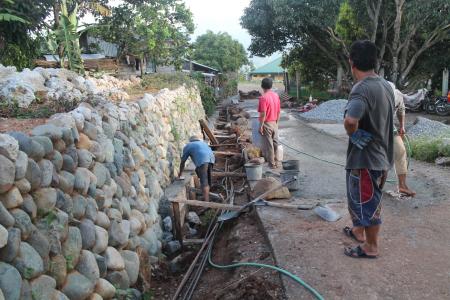Kayan West is one of the 19 barangays that comprise the municipality of Tadian in Mountain Province. The community is inhabited by the Kankanaey, one of the many indigenous peoples collectively known as the Igorot who call the Cordillera region their home. The Kanakanaey have an intimate relationship with their environment, believing that the land is the source of everything that has sustained their existence since time immemorial. As such, the community members derive their livelihood mainly from planting rice, corn, peanuts and other vegetables.
Before the Second World War, Kayan was the rice granary of Tadian. But recently, due to the steady onset of drought during summer, rice production has decreased and villagers are faced with reduced water supply for daily use. Also, during the dry season, the community experiences heavy forest fires. On the other hand, the wet season is characterized periods of continuous rainfall and strong typhoons that increase soil erosion, trigger landslides and damage crops. In 2010, heavy rainfall brought by Tropical Storm Parma induced a massive landslide in Kayan East causing widespread damage and loss of life.
The process began with a community risk assessment (CRA) which helped paint a clear picture of the local situation and also served as the basis for future interventions. Various capacity-building activities were then conducted to increase knowledge and awareness of the residents. The next step involved planning sessions wherein the results from the CRA and training activities were consolidated into contingency and risk reduction plans that would help the community prepare for disasters and at the same continue to address the underlying causes of vulnerabilities. Finally, small-scale mitigation measures were implemented to address some of the immediate problems identified in the CRA. These measures included tree planting activities in landslide prone areas and establishment of drainage canals to protect rice fields and vegetable gardens.
Throughout the implementation process, emphasis was placed on community participation. From the start, they were given a leading role whether it was discussing the community risk situation or identifying appropriate mitigation measures for soil erosion. Traditional knowledge was built upon and integrated into the interventions. Also, activities and schedules were adjusted based on the local situation. According to the community, putting them in the lead motivated them to actively participate in the project and work hard to improve their situation.
Today, some impacts of the project are already being observed. The barangay was awarded most functional Barangay Disaster Risk Reduction and Management Committee (BDRRMC) three times by the municipality of Tadian since the start of the project. Basis for the award was the completeness of DRR plans, presence of a community risk assessment and implementation of DRR-related programs and projects. Representatives from the barangay were also invited to serve as resource persons during a municipal-wide contingency planning workshop.
Impacts are also seen in the changing attitudes of the residents. According to them, the increased knowledge and awareness was one of the most important things they gained from the project. They are now able to look more critically not just at disasters but also the underlying causes of vulnerabilities. They have become more proactive in searching for solutions to their problems without relying external sources. Additionally, the knowledge they gained from PfR is also being used in implementing other projects. The CRA was used to plan for a new community water system to ensure that it was risk-proof and environmentally sustainable.
Initiatives started by PfR have been scaled-up or maintained. Tree planting in landslide-prone areas that started out as a small-scale mitigation measure has continued every year and the barangay council has issued an ordinance to institutionalize this practice. The barangay contingency plan and risk assessment are constantly being updated based changes in the local situation. The barangay development plan has also been modified to reflect the DRR-CCA-EMR approach.
Finally, PfR has contributed to strengthening indigenous practices that can help the community prepare for and cope with the impacts of hazards and disasters. Ob-obbo is a system of cooperative endeavor wherein the whole community works together for a common goal such as construction of a neighbor’s house or repair of a community irrigation canal. But according to residents, this practice has slowly been fading in the past few years. Through the help of PfR, the community members expressed that they have realized again the importance of this practice. Today, ob-obbo is now being done regularly not just to fix structures but also to plant trees, clean the community watershed, create fire lines to prevent forest fires and clear waterways to prevent accumulation of water.
Overall, Kayan West has shown how the integrated approach works when used in actual practice. The result is a community where resilience is not only seen in the presence of plans and mitigation measures but in the change of attitudes and improved practices.
By using the integrated approach in combination with putting the community in the forefront, a strong foundation can be built on the way to achieving true community resilience.

